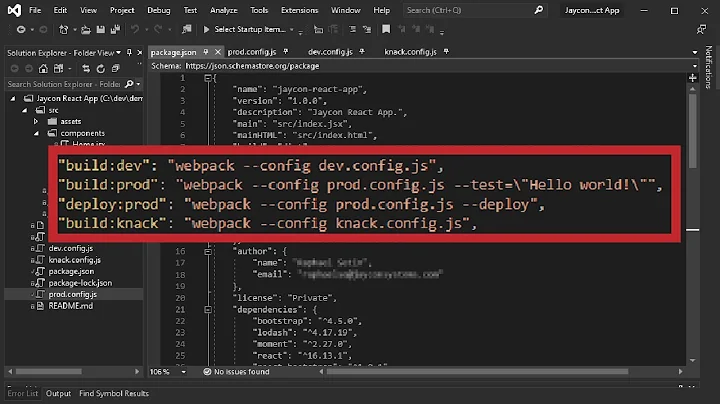How to use multiple configuration files in webpack?
Solution 1
There are some ways to accomplish that. Perhaps the simplest one is specifying the config file to use. Read more about webpack usage with config file.
Add another script in your package.json with:
"build": "webpack --config ./path-to/webpack.config.prod.js"
Place your production config object inside webpack.config.prod.js.
Another way is using the npm lifecycle event.
Update your current webpack.config.js script to check the target script and decide which config to use:
const TARGET = process.env.npm_lifecycle_event;
if (TARGET === 'dev') {
module.exports = require('./path-to/webpack.config.dev.js');
}
if (TARGET === 'build') {
module.exports = require('./path-to/webpack.config.prod.js');
}
You can find previous approach in this webpack-demo project on GitHub.
Solution 2
A few options:
-
use webpack-merge
-
use multiple configurations and choose between them using the --config-name option
-
If you don't mind changing your webpack config object (module.exports) into a function as described here you could do something like this in your webpack.config.js:
module.exports = (env, argv) => { return { //your config here, do something with the mode mode: env.mode }; };
and pass the mode into your config by invoking webpack with the --env flag:
npx webpack --env mode=development
Or just add it to your package.json like this:
"scripts": {
"watch": "webpack --watch --env mode=development",
"build": "webpack --env mode=production"
}
Although if all you want is to toggle the mode you could just use the --mode flag
Solution 3
In watch mode you can run webpack with NODE_ENV prefix from package.json, for example:
{
...
"scripts": {
"watch": "NODE_ENV=development webpack --watch",
"build": "NODE_ENV=production webpack",
...
}
}
and then use that preset (process.env.NODE_ENV) in webpack.config.js:
const mode = process.env.NODE_ENV;
const config = {
mode,
// ... common configuration
};
if (mode === 'development') {
// update config object for development
} else if (mode === 'production') {
// update config object for production
}
module.exports = config;
Solution 4
The npm module webpack-merge is a confortable way of having multiple configuration files in webpack. It allows to have a common configuration file and several other that "extend" from this one as the following example will show.
Installing
npm install webpack-merge
Common webpack config file
This would be where the common configurations between your other files are.
webpack.common.js
const path = require("path");
const HtmlWebpackPlugin = require("html-webpack-plugin");
const { CleanWebpackPlugin } = require("clean-webpack-plugin");
module.exports = {
entry: "./src/index.js",
plugins: [
new CleanWebpackPlugin(),
new HtmlWebpackPlugin({
title: "Output Management",
template: "src/index.html",
}),
],
output: {
filename: "bundle.js",
path: path.resolve(__dirname, "dist"),
},
};
Extending files
I decided to use development and production configuration files for the example but any amount can be used.
webpack.dev.js
const path = require("path");
const { merge } = require("webpack-merge");
const common = require("./webpack.common.js");
module.exports = merge(common, {
mode: "development",
devServer: {
contentBase: path.join(__dirname, "dist"),
compress: true,
port: 9000,
},
});
webpack.prod.js
const { merge } = require("webpack-merge");
const common = require("./webpack.common.js");
module.exports = merge(common, {
mode: "production",
});
In both you import the merge function and use it to create your files without having to duplicate code. In your scripts you can simply call the extending configuration files like so.
package.json
...
"scripts": {
"build": "webpack --config webpack.prod.js",
"dev": "webpack serve --config webpack.dev.js"
},
...
Related videos on Youtube
Kousher Alam
Updated on January 03, 2022Comments
-
 Kousher Alam over 2 years
Kousher Alam over 2 yearsI'm building a webpack automated workflow. I completed the development server. All of my development configurations are in
webpack.config.jsfile.Then, I add it into
package.jsonscript via'dev':'webpack-dev-server'How would one make a configuration for production in a separate file?
-
 VimNing about 2 yearsBut what's the real advantage to have so many webpack configs?
VimNing about 2 yearsBut what's the real advantage to have so many webpack configs?
-
-
Jonathan about 5 yearsIf the files have commonalities, how would one include the commonalities (i.e. a
webpack.config.core.js)? -
Carloluis about 5 yearsYou might extract those commonalities into a third config file as you mentioned (e.g.:
webpack.common.js). That script is then referenced and its config is extended with the environment specific parts. Hint: webpack-merge is commonly used for this task. Hope this comment answers part of your question. If not, feel free to create a question with more information and give me a reference to check it out. -
 VimNing about 2 yearsBut what's the real advantage to have so many webpack configs?
VimNing about 2 yearsBut what's the real advantage to have so many webpack configs? -
 VimNing about 2 yearsBut what's the real advantage to have so many webpack configs?
VimNing about 2 yearsBut what's the real advantage to have so many webpack configs? -
 VimNing about 2 yearsBut what's the real advantage to have so many webpack configs?
VimNing about 2 yearsBut what's the real advantage to have so many webpack configs? -
 jogarcia about 2 years@Rainning It depends on the complexity of the app you are building. A dev build usually is bigger and heavier but it has better error support and warnings while a production environment is the other way around. You can't have both things the same time
jogarcia about 2 years@Rainning It depends on the complexity of the app you are building. A dev build usually is bigger and heavier but it has better error support and warnings while a production environment is the other way around. You can't have both things the same time




